Coral Bleaching Heat Stress Analysis and
Seasonal Guidance through June 2024
(Released March 7, 2024)
Current conditions:
NOAA Coral Reef Watch's near real-time satellite monitoring shows that as of March 6, 2024, above-average sea surface temperatures (SSTs) continue across the entire equatorial Pacific Ocean, with the exception of a recently-emerged stretch of below-average SSTs to the west of the Galápagos Islands. SST anomalies are highest (>3°C) in the eastern equatorial Pacific, east of the Galápagos Islands and along the central and southern American coasts; in the northwestern Pacific near northern Japan; and in the southwestern Pacific surrounding Australia's southern Great Barrier Reef (GBR) and points south (Figure 1). A swath of below-average SSTs also remains in the northeastern Pacific, stretching south and east from the Main Hawaiian Islands. In the Northwestern Hawaiian Islands (NWHI), above-average SSTs persist from Lisianski Island to Kure Atoll.
As of February 8, 2024, the NOAA National Centers for Environmental Prediction's (NCEP) ENSO Alert System status remains at El Niño Advisory, but also with the addition of a La Niña Watch. A transition from El Niño to ENSO-neutral is likely by April-June 2024 (79% chance), with increasing odds of La Niña developing in June-August (55% chance).
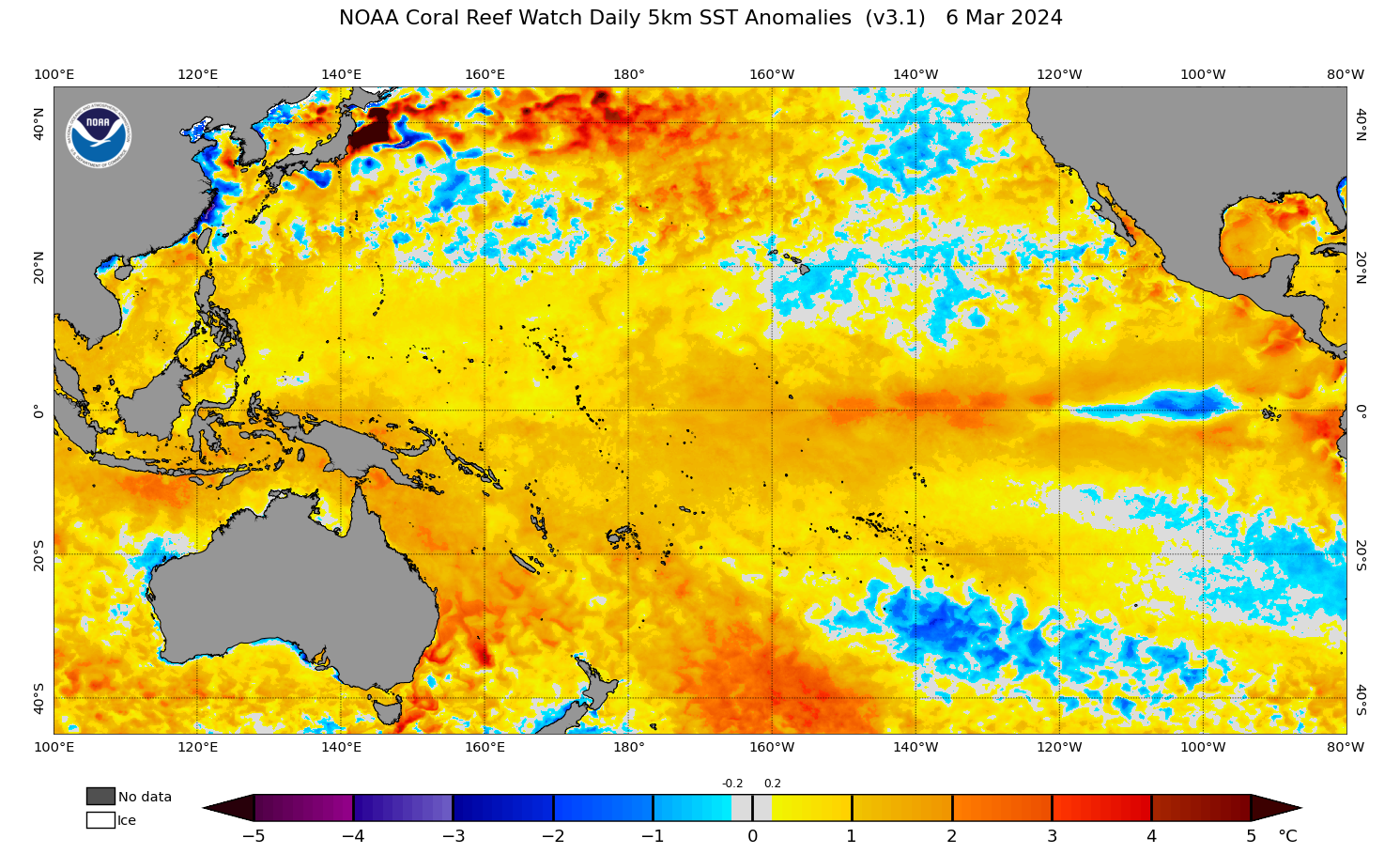
|
||
|
Figure 1. NOAA Coral Reef Watch's Satellite Sea Surface Temperature (SST) Anomaly product for the Pacific region. |
||
Over the past three months, Coral Bleaching HotSpots >1°C have evolved and expanded southwesterly, from the central equatorial Pacific near the northern Line Islands, toward the GBR (Figure 2). This has affected the large swath of islands in-between, including the Phoenix Islands (Kiribati), Northern Cook Islands, Tuvalu, American Samoa, Wallis and Futuna, Northern and Southern Tonga, Fiji, Vanuatu, New Caledonia, and the entire expanse of the GBR. NOAA CRW's daily 5km satellite Regional Virtual Stations currently show every GBR Station is at Bleaching Alert Level 2, as are the Stations for Western New Caledonia, Vanuatu, Fiji, Northern Tonga, American Samoa, and the Northern Cook Islands. Wallis and Futuna, Southern Tonga, and Eastern New Caledonia are at Alert Level 1. South Pacific areas east of the Cook Islands are at Bleaching Watch. In the eastern Pacific, Costa Rica and the Galápagos Islands are at Alert Level 2 (Figure 3).
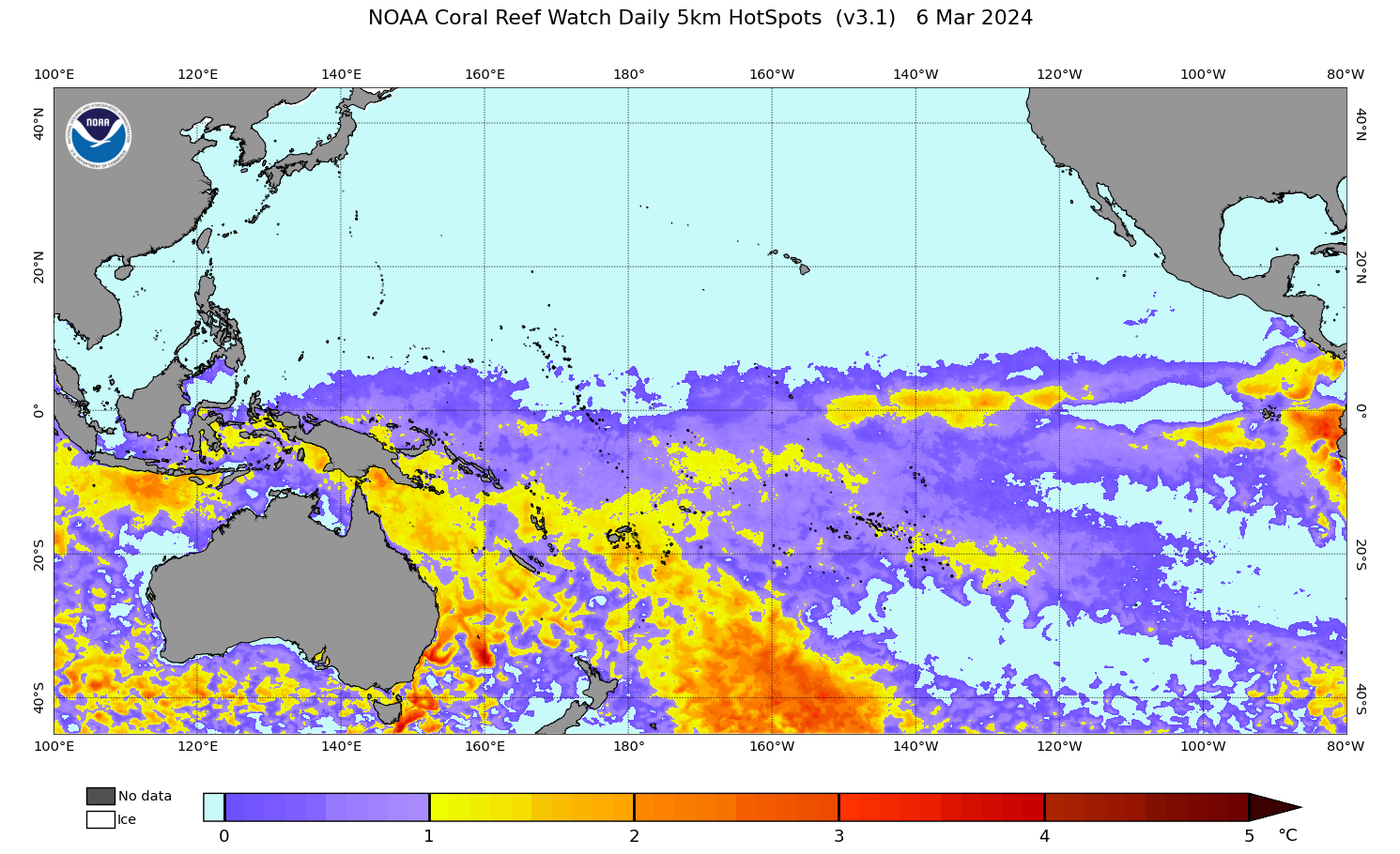
|
||
|
Figure 2. NOAA Coral Reef Watch's Satellite Coral Bleaching HotSpot product for the Pacific region. |
||
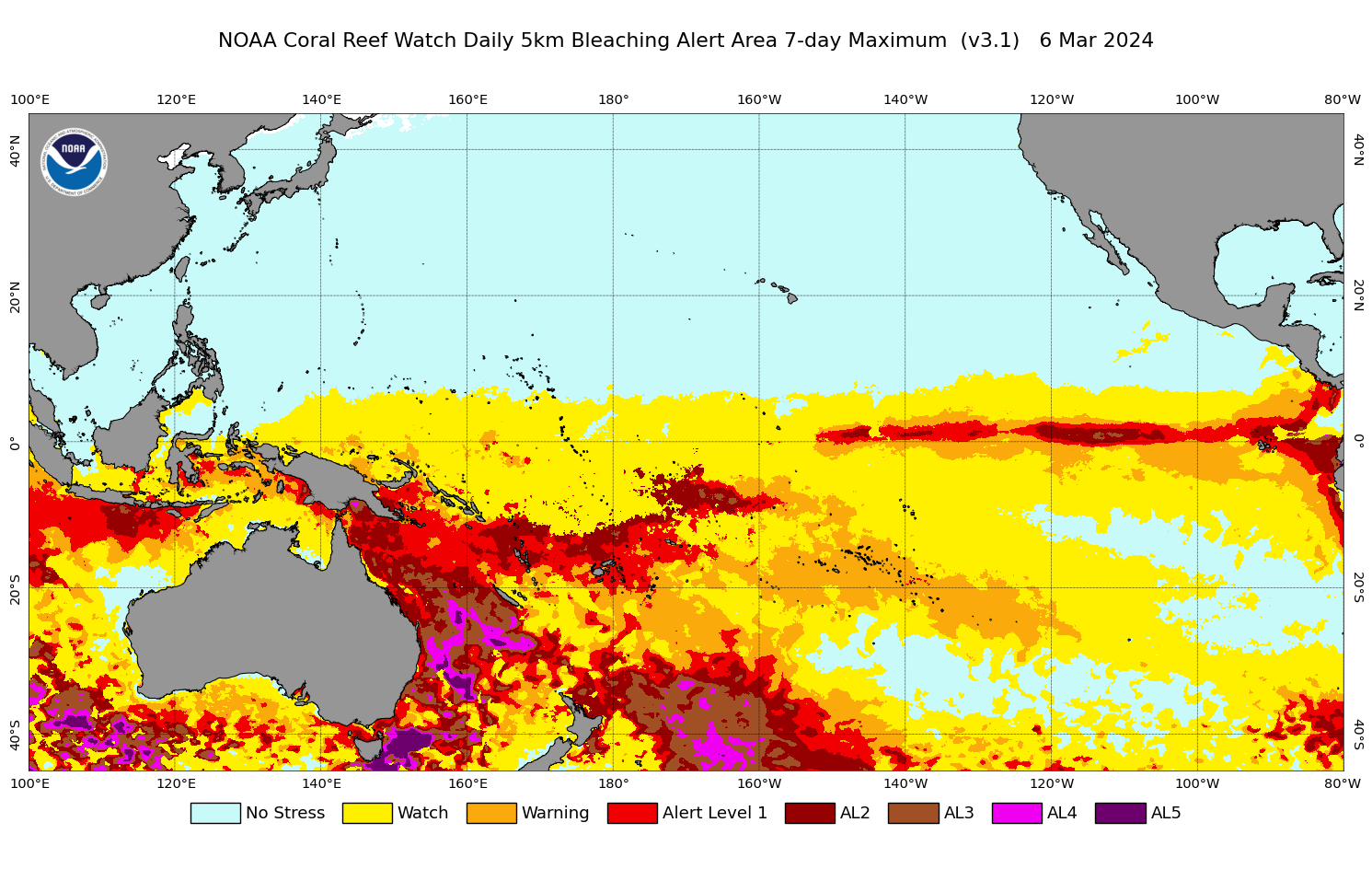
|
||
|
Figure 3. NOAA Coral Reef Watch's Satellite Bleaching Alert Area (7-day maximum) product for the Pacific region. |
||
**NOTE**: On December 15, 2023, NOAA CRW implemented a revised coral bleaching heat stress category system for its Bleaching Alert Area product. Extreme accumulations of coral bleaching heat stress in 2023, in multiple regions of the world, especially in the eastern tropical Pacific Ocean and Greater Caribbean, which were confirmed by in-water observations, necessitated the introduction of additional Bleaching Alert Levels. This development is a refinement of the original system that only used Bleaching Alert Levels 1 and 2. The new Alert Levels 3-5 provide important, added detail, for when the magnitude of extreme heat stress exceeds the threshold of Alert Level 2 conditions.
For managers: we understand that coral bleaching response plans, incident action plans, and restoration plans around the world rely on NOAA Coral Reef Watch's Bleaching Alert Levels, to assist with planning and implementation of work by your in-water monitoring and management networks. Any actions you would have taken previously at Bleaching Alert Level 2 still apply. We recognize, however, that discussions may need to occur now, regarding appropriate actions for your networks when the extreme Bleaching Alert Levels 3-5 are predicted.
Since December 2023, coral bleaching has been reported at Palmyra Atoll in the Northern Line Islands, with newer reports (January and February 2024) showing more extensive bleaching, mortality, and algal overgrowth (Photo Collage 1). Extensive bleaching was also observed in Tuvalu, Kiribati, and Fiji as of February 2024, with reports from Funafuti of 70% of the corals "gone" inside the lagoon. In March 2024, the Great Barrier Reef Marine Park Authority, in collaboration with the Australian Institute of Marine Science, completed aerial surveys of 300 reef areas and confirmed a widespread, mass coral bleaching event. In the eastern Pacific, in Costa Rica, different coral restoration groups also reported 50-80% bleaching on reefs they surveyed.
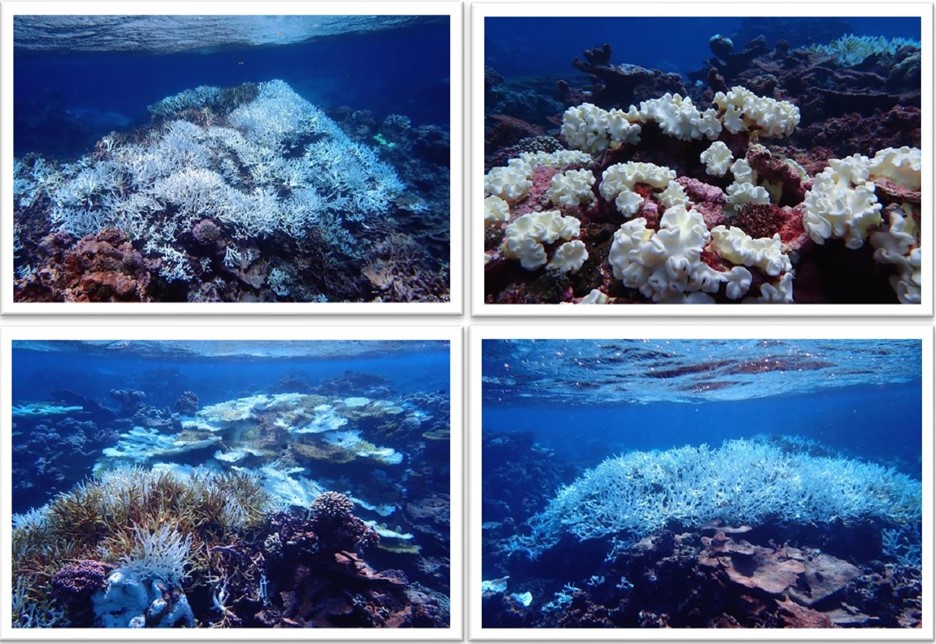
|
||
|
Photo Collage 1. Mass coral bleaching on Palmyra Atoll, December 28, 2023. Credit: The Nature Conservancy. POC: Molly Ginther. |
||
NOAA CRW would be very grateful if local stakeholders would continue sharing their in-water data and observations of coral bleaching/no bleaching, to inform what has been and is being observed on their reefs. Users can contribute their data to NOAA CRW via email (to coralreefwatch@noaa.gov), a Google Form, and/or via a more detailed, quantitative observations questionnaire. (Please see https://coralreefwatch.noaa.gov/satellite/research/coral_bleaching_report.php for more information.)
Predicted conditions:
NOAA CRW's most recent, modeled Four-Month Coral Bleaching Outlook (Figure 4) projects heat stress will remain in the southwestern Pacific Ocean through March 2024, but recede by April. Alert Level 2 heat stress is predicted to persist around Fiji and American Samoa through April 2024, and expand eastward toward French Polynesia by late March.
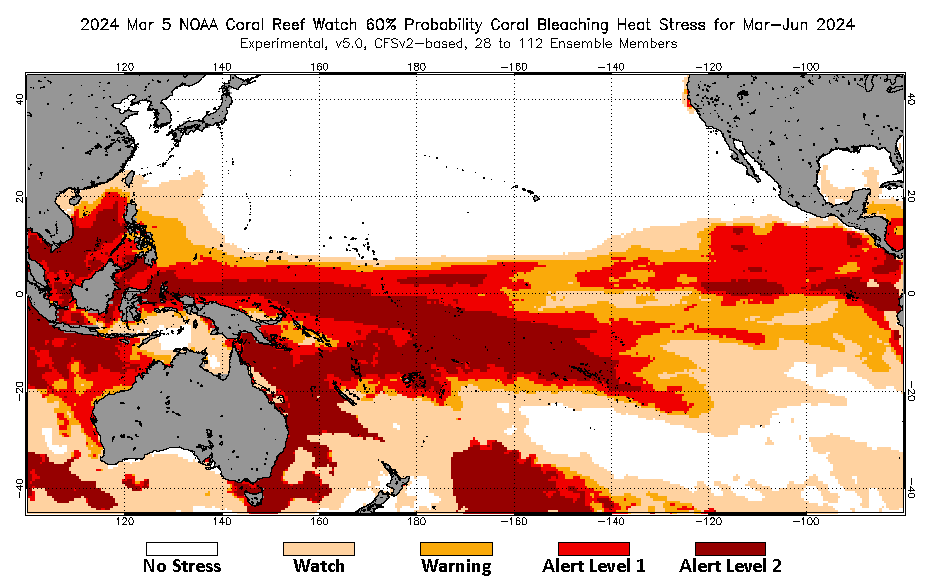
|
||
|
Figure 4. NOAA Coral Reef Watch's Four-Month Coral Bleaching Outlook of March 5, 2024, for the period March-June 2024, for the Pacific region. |
||
***CRW recommends regular review of its Four-Month Coral Bleaching Outlook maps (https://coralreefwatch.noaa.gov/satellite/bleachingoutlook_cfs/index.php) and near real-time satellite product updates (https://coralreefwatch.noaa.gov/product/5km/index.php), for all regions of interest/concern, over the months ahead.***
CRW's current satellite and modeled products can be found at:
https://coralreefwatch.noaa.gov/index.php
CRW's modeled Four-Month Coral Bleaching Heat Stress Outlooks can be found at:
https://coralreefwatch.noaa.gov/satellite/bleachingoutlook_cfs/outlook_cfs.php
CRW's 5km satellite Regional Virtual Stations can be found at:
https://coralreefwatch.noaa.gov/product/vs/map.php
Sign up for automated bleaching alert emails for CRW's 5km Regional Virtual Stations at:
https://coralreefwatch.noaa.gov/subscriptions/vs.php
Please report bleaching events (or non-events) at:
https://coralreefwatch.noaa.gov/satellite/research/coral_bleaching_report.php
Disclaimer
The content posted on this web page solely represents the opinions of the authors and does not constitute a statement of policy, decision, or position on behalf of NOAA or the US Government.
The appearance of external links on this World Wide Web site does not constitute endorsement by the Department of Commerce/National Oceanic and Atmospheric Administration of external Web sites or the information, products or services contained therein. For other than authorized activities, the Department of Commerce/NOAA does not exercise any editorial control over the information you may find at these locations. These links are provided consistent with the stated purpose of this Department of Commerce/NOAA Web site.